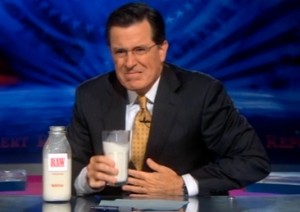The demand for unpasteurized milk and vaccine-free kids in the Western world prompts a question: what are you afraid of?
 Maura Rhodes of Parade writes that sociologists often refer to fears shared by a group as “moral panics.” The Holocaust and 9/11 were certainly legitimate reasons for large groups of people to be afraid. But some pretty silly stuff has triggered mass panic over the years. In 1878, for example, a New York Times editorial suggested that Thomas Edison had “invented too many things” and that “something ought to be done to Mr. Edison, and there is a growing conviction that it had better be done with hemp rope.” Around the same time, folks were up in arms about the danger of “selfish and unsocial species of warfare which two of a company carry on for hours together.” The evil activity in question? Chess! (Take that, Minecraft!)
Maura Rhodes of Parade writes that sociologists often refer to fears shared by a group as “moral panics.” The Holocaust and 9/11 were certainly legitimate reasons for large groups of people to be afraid. But some pretty silly stuff has triggered mass panic over the years. In 1878, for example, a New York Times editorial suggested that Thomas Edison had “invented too many things” and that “something ought to be done to Mr. Edison, and there is a growing conviction that it had better be done with hemp rope.” Around the same time, folks were up in arms about the danger of “selfish and unsocial species of warfare which two of a company carry on for hours together.” The evil activity in question? Chess! (Take that, Minecraft!)
So, why, despite our lofty perch on the evolutionary tree of life, do we of opposable thumbs and logic-capable minds break into en masse sweat in response to things that are as likely to harm us as reindeer are to fly?
Survival Over Common Sense
It turns out that when it comes to fear, our superior brains are no more superior than, well, a reindeer’s—or even a bacterium’s.
“The human brain is a survival machine, not a figure-it-out computer,” says risk perception expert David Ropeik, author of How Risky Is It, Really? Why Our Fears Don’t Always Match the Facts. “After you wake up in the morning, its primary job is to get you safely to bed at night, not to get good grades or discover something.”
To do this, the brain relies on what neuroscientist Dr. Joseph LeDoux, author of The Emotional Brain: The Mysterious Underpinnings of Emotional Life, refers to as “threat-triggered defense responses”—the clammy hands, goose bumps, weak knees and other sensations that we associate with fear (see Your Body On Fear, page 6).
 These defense responses have nothing to do with reason. The part of the brain that detects danger, the amygdala, is simply a switch that flips on so that the body can react—ASAP—to a potential threat. Because of its location in the brain, it receives sensory information before the prefrontal cortex, the thinking part of the brain, explains Ropeik. That means that the body will go into fight-flight-or-freeze mode before our minds can make sense of what’s going on. More importantly, it means that it’s only human to experience so-called irrational fear. If we didn’t, we wouldn’t be here.
These defense responses have nothing to do with reason. The part of the brain that detects danger, the amygdala, is simply a switch that flips on so that the body can react—ASAP—to a potential threat. Because of its location in the brain, it receives sensory information before the prefrontal cortex, the thinking part of the brain, explains Ropeik. That means that the body will go into fight-flight-or-freeze mode before our minds can make sense of what’s going on. More importantly, it means that it’s only human to experience so-called irrational fear. If we didn’t, we wouldn’t be here.
Of course, news outlets stoke the fire of collective fear. “The media loves to tap into the fear response because it doesn’t engage with the rational mind. Scary headlines and disturbing images are captivating,” says sociologist Dr. Margee Kerr, whose book Scream: Adventures in the Upside of Fear comes out in October.
Adds Dr. Christopher Bader, a professor of sociology and the lead researcher of the Chapman University Survey on American Fears (see Fear This, Not That, page 5): “People often don’t realize that when they’re watching the news they’re watching the worst possible scenario. That’s why it’s news: A serial killer gets airtime because he’s rare, not because serial murders are on the rise.”


 I love traveling and eating just about anything in sight. My only rule is that food can’t be too spicy. That’s why
I love traveling and eating just about anything in sight. My only rule is that food can’t be too spicy. That’s why  But where does my own perception of risk associated with foods come from? How is it different from the next person’s? Is one influenced by old wise tales, cultural norms, or scientific facts, or even blessed with good genes? Or is it a matter of adjusting one’s intestines to certain pathogens? How tolerant is a native person to certain foods compared to a foreigner? Or does your vulnerability to foodborne illness relate to your perception of risk? (For vulnerabilities, see
But where does my own perception of risk associated with foods come from? How is it different from the next person’s? Is one influenced by old wise tales, cultural norms, or scientific facts, or even blessed with good genes? Or is it a matter of adjusting one’s intestines to certain pathogens? How tolerant is a native person to certain foods compared to a foreigner? Or does your vulnerability to foodborne illness relate to your perception of risk? (For vulnerabilities, see 